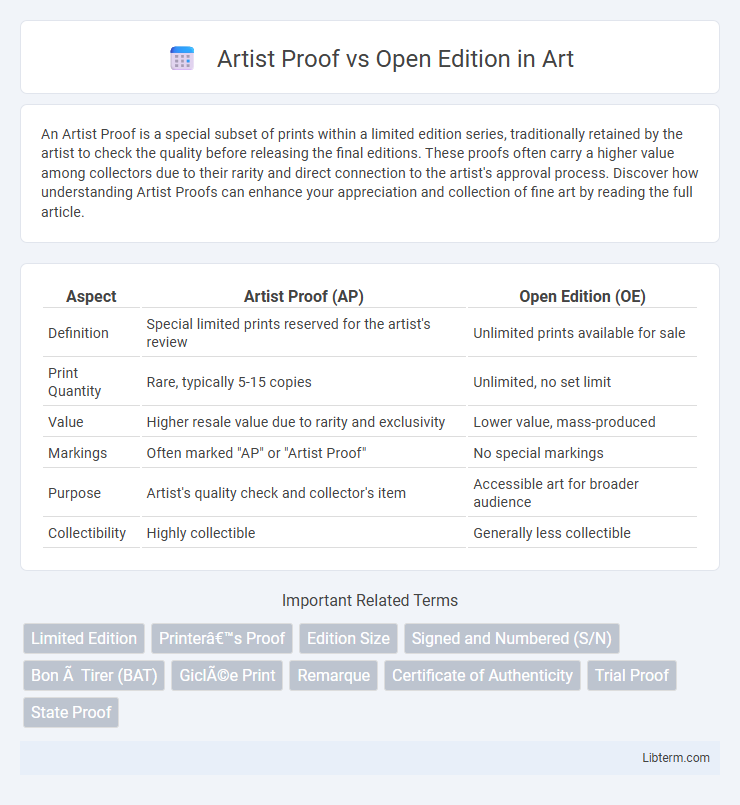An Artist Proof is a special subset of prints within a limited edition series, traditionally retained by the artist to check the quality before releasing the final editions. These proofs often carry a higher value among collectors due to their rarity and direct connection to the artist's approval process. Discover how understanding Artist Proofs can enhance your appreciation and collection of fine art by reading the full article.
Table of Comparison
| Aspect | Artist Proof (AP) | Open Edition (OE) |
|---|---|---|
| Definition | Special limited prints reserved for the artist's review | Unlimited prints available for sale |
| Print Quantity | Rare, typically 5-15 copies | Unlimited, no set limit |
| Value | Higher resale value due to rarity and exclusivity | Lower value, mass-produced |
| Markings | Often marked "AP" or "Artist Proof" | No special markings |
| Purpose | Artist's quality check and collector's item | Accessible art for broader audience |
| Collectibility | Highly collectible | Generally less collectible |
Introduction to Artist Proofs and Open Editions
Artist Proofs (APs) are limited prints reserved for the artist's personal use or archival purposes, often marked as AP and traditionally represent a small percentage of the total edition, enhancing their rarity and value. Open Editions consist of unlimited reproductions of an artwork, making them widely accessible and more affordable compared to limited runs, but with less exclusivity and collector appeal. Collectors typically seek Artist Proofs for their uniqueness and potential investment value, while Open Editions are favored for decorative purposes and broader distribution.
Defining Artist Proof: Meaning and Origin
Artist Proofs (APs) are specially reserved prints in a limited edition run, traditionally kept by the artist for personal use or sale. Originating from printmaking, these proofs serve as a quality check before the main edition is produced, often making them rarer and more valuable than the Open Editions. Unlike Open Editions, which are produced in unlimited quantities, Artist Proofs typically represent a small percentage of the total prints created.
What Is an Open Edition Print?
An open edition print refers to an artwork reproduced without a predetermined limit on the number of copies produced, allowing unlimited prints to be made over time. This type of print contrasts with an artist proof, which is a limited and often more valuable subset of prints created during the initial production phase. Open edition prints are typically more affordable and widely accessible to art collectors and enthusiasts.
Differences in Production Processes
Artist Proofs (AP) are limited prints made before the main edition, often used by the artist to check quality and color accuracy, resulting in a smaller, exclusive batch with unique characteristics. Open Editions produce a larger number of prints without a strict limit, allowing continuous production often using automated or mass printing techniques. The main difference lies in APs being handcrafted and inspected for quality, while Open Editions emphasize volume and accessibility.
Rarity and Collectibility Compared
Artist Proof prints are highly sought after due to their limited quantity, often representing only a small percentage of the total edition, which significantly enhances their rarity and collectibility. In contrast, Open Edition prints are produced without a fixed limit, making them more accessible but less exclusive and generally less valuable to collectors. The scarcity of Artist Proofs combined with their direct connection to the artist typically results in higher demand and greater investment potential.
Value and Pricing: Artist Proof vs Open Edition
Artist Proof prints generally hold higher value and command premium pricing due to their limited quantity and rarity. Open Edition prints are produced in larger numbers, resulting in more affordable prices but less exclusivity. Collectors often prioritize Artist Proofs for investment potential and unique status within an artwork series.
Collector Preferences and Market Demand
Collector preferences often favor Artist Proofs due to their limited availability and higher perceived rarity, driving stronger market demand and premium pricing. Open Edition prints, produced in larger quantities without limitation, appeal to collectors seeking affordability and accessibility rather than exclusivity. Market trends indicate that Artist Proofs maintain better long-term value, while Open Editions serve as entry points for newer collectors.
Authenticity and Markings Explained
Artist Proofs are limited prints created alongside the main edition, often marked with "AP" and signed by the artist, enhancing their authenticity and collectible value. Open Edition prints have no fixed limit, usually lack special markings or signatures, and are less exclusive, making authenticity verification simpler but less prestigious. Collectors prioritize Artist Proofs for their rarity, distinct markings, and direct artist involvement, differentiating them from mass-produced Open Editions.
Investment Potential: Which Is Better?
Artist Proof prints typically hold greater investment potential due to their limited quantity and exclusivity, often commanding higher resale values. Open Edition prints are produced in unlimited numbers, making them more accessible but less likely to appreciate significantly over time. Collectors seeking long-term value tend to prioritize Artist Proofs for their rarity and potential scarcity-driven demand.
Choosing Between Artist Proof and Open Edition
Choosing between Artist Proof and Open Edition depends on the collector's preference for exclusivity and potential investment value. Artist Proofs are typically more limited, often representing a small subset of the print run, making them rarer and usually more desirable among serious collectors. Open Editions offer unlimited prints, making them more accessible and affordable but generally less valuable in the long term compared to Artist Proofs.
Artist Proof Infographic

 libterm.com
libterm.com